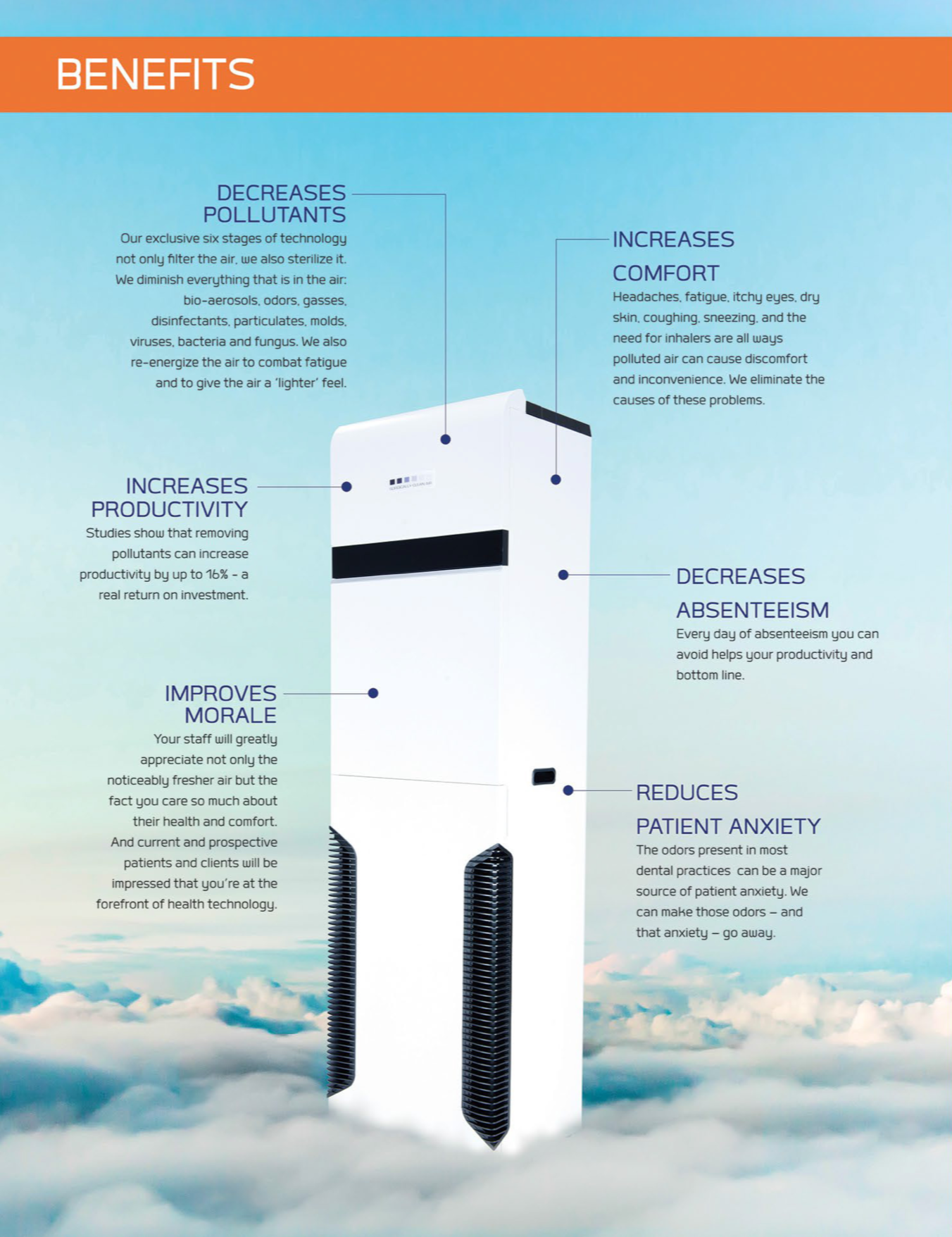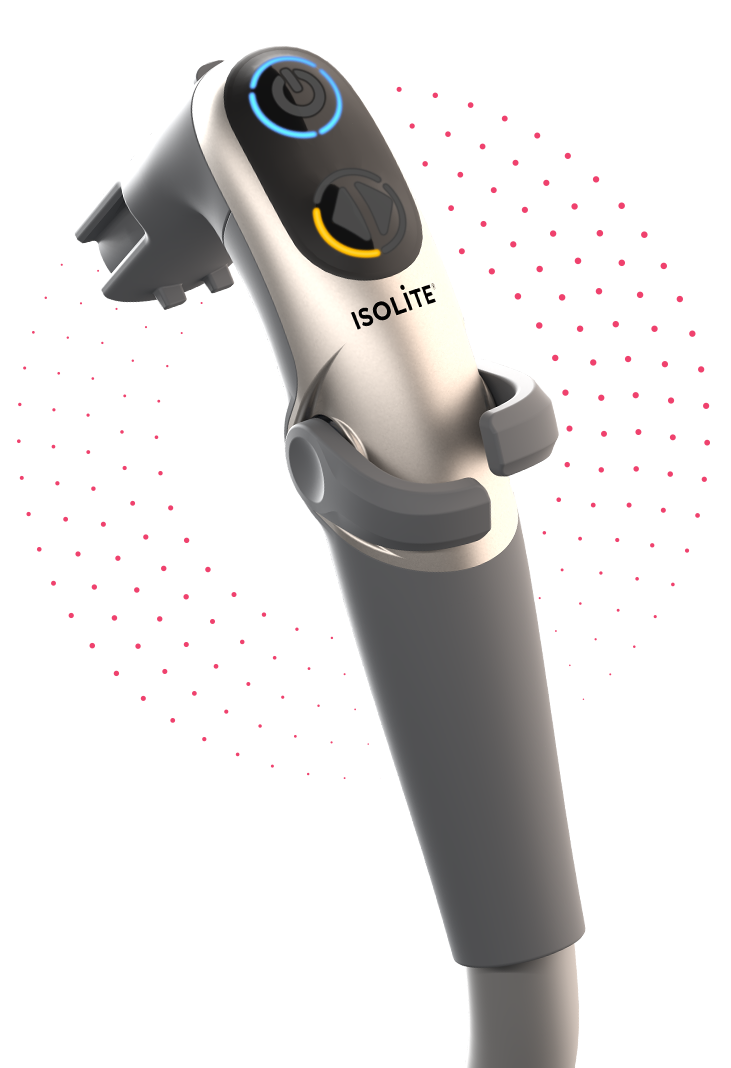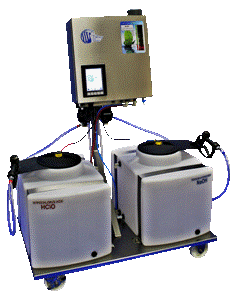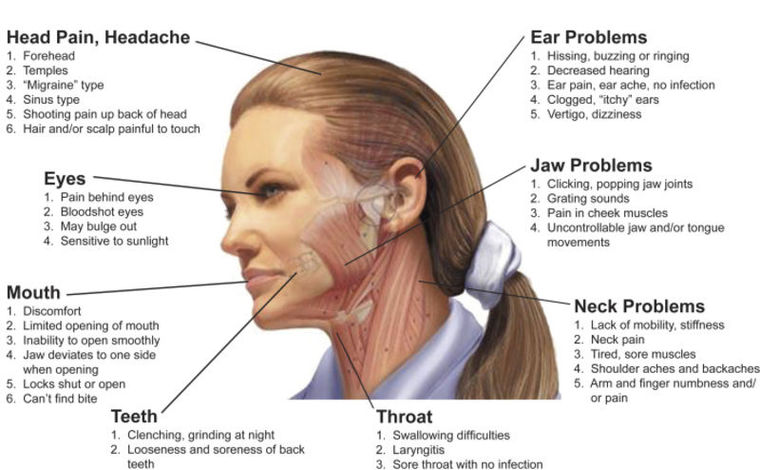Dental offices are high traffic spaces: our regular, daily interactions with patients can introduce bacterial, viral, and fungal infections into the air. The indoor air within dental offices contains unhealthy and often infectious airborne pollutants, but we believe technology keeps our patients happier and healthier. Here are three major ways we use cleaning technology to ensure our patients and staff members are as protected as possible:

Microbial air pollution is a real health issue and this is where technology makes us a better, healthier practice. Air purification systems can play a role in significantly reducing transmittable bio-aerosols Dental procedures inadvertently generate aerosols, containing organisms and debris from each patient’s oral activity, and these can be harmful to everyone present in the clinic. Air filters result in the significant reduction of viable particles in the air. World-class medical-grade air purifiers like our Surgically Clean Air system remove chemicals, toxins, germs, and odors, but most importantly, they kill airborne viruses, to help reduce the spread of illness.
By using a six-stage purification system of filters and UV lights, we ensure that the air you breathe is clean, healthy, and odor-free. Stages 1 and 2 remove large and microscopic air contaminates. Stage 3 absorbs unhealthy odors, chemicals, and gases. Stages 4 and 5 kill bacteria and viruses, while stage 6 re-energizes the clean air before circulating it back into the room.
We invested in Surgically Clean Air systems within our office because we believe that paying attention to the quality and purity of the air in our office creates a win/win situation for our patients and team members. Learn more about what Surgically Clean Air is doing for other practices HERE.

“Isolation”, in dental terms, means keeping the procedure area (your mouth) safe and contained. Proper dental isolation is important to dental procedures because it minimizes contamination. This is traditionally done with dental dams and other tools for suction, but we use Isolite systems with our patients. Isolite technology is soft and comfortable, but provides added safety measures during your dental procedure, protecting you foreign body aspiration and shielding the tongue and cheek from injury by the handpiece or other dental instruments.

As an added step in our office safety, we are soon implementing a Viking Technology Cleaning System within the practice. Viking Pure’s patented e-water is a nontoxic solution that has the power to redefine our idea of a clean environment. The chemicals that our society has come to rely on are harmful to our health, our wallet and our planet. They are also ineffective at killing the bacteria, viruses and superbugs that are plaguing our homes and businesses.
Viking Pure Solutions are not only more powerful than chemicals, but our patent-protected systems have revolutionized the very process of generating natural cleaning solutions. Electrolyzed Water is the result of a process called electrolysis: salt is electrically separated into its two main ions, sodium and chloride. Those two ions are then mixed into separate streams of fresh water, producing two solutions: Hypochlorous Acid (PureSan) and Sodium Hydroxide (PureClean). These two solutions are safer, cheaper and most importantly, infinitely more powerful than the harmful chemicals most commonly used as cleaning agents today.
After a very long 2 months, we look forward to bringing our patients back into the office for treatment. Fortunately, many of the new safety precautions recommended to dentists have been in place in our office long before COVID-19. We look forward to seeing you.

Our patients often ask us about oil pulling, or ‘swishing’: it’s an alternative treatment purported to rid your body of unwanted bacteria through the process of swishing vegetable oil (mostly coconut oil) around your mouth. Those who swear by the process claim that it whitens teeth, fights bad breath, and gets rid of bacteria stuck in hard to reach places.
We totally support alternative wellness, even when it comes to your teeth. Understand that oil pulling may sound like a great alternative oral care solution, but it can never replace brushing and flossing. Here's some real talk about oil pulling and how we think it can be beneficial:
What is oil pulling?
The process of oil pulling involves putting a tablespoon of liquid vegetable oil, often coconut oil, into your mouth and swishing it around for 20 minutes before spitting it out and brushing it away with a toothbrush and toothpaste. The process gets its name partly from the pushing and pulling of the oil through teeth and mouth, and partly from the way the oil is supposed to pull icky stuff out of your mouth tissues.
The longer you push and pull the oil through your mouth, the more microbes are pulled free. The oil needs to be swished around long enough for it to turn a milky white, which indicates that the bacteria has been "pulled" off. After roughly 20 minutes the solution is filled with bacteria, viruses and other organisms; at this point, the person spits out the oil and rinses thoroughly with water.
How does oil pulling work?
The number of bacteria found in our mouths is usually between 1,000 and 10,000 on each individual tooth. It may sound like a lot, but these guys are tiny! Each of these bacteria have a fatty outer coating, and when they come into contact with another fatty substance, such as oil, they have a tendency to stick to that substance. Since liquid oil has the ability to get into hard to reach areas of the mouth that a toothbrush would miss, it is thought to be able to pick up bacteria that may have otherwise stayed hidden.
People that “oil pull” state that it has helped whiten their teeth, alleviate halitosis, and even reduce gingivitis. In many cases, people also claim that it helps “prevent” cavities, as well as relieve gum and tooth sensitivity.
What we believe
There is clear evidence that many diseases and conditions are influenced by the mouth’s ecology and bacteria, and we understand the topic of oil pulling is valid when patients wonder why oil pulling has been encouraged by dental professionals as a supplemental therapy for patients, especially if we are in the business of “preventing” oral health problems.
We support holistic approaches to your oral care. You just have to be smart about it and consider your individual dental health: there are certain types of infections that oil pulling will not resolve, and you have to be aggressive about treating those. It won’t take away raging gum infections or cavities. Oil pulling may remove bacteria, but it doesn't kill bacteria, and that's a big difference.
BOTTOM LINE
If oil pulling is used alone, without regular brushing and flossing, then no, it is not an effective way to keep your mouth healthy. It will not heal existing decay. However, when used in conjunction with proper daily brushing and flossing habits as a preventive measure, it may improve bad breath, help to decrease staining, and benefit in other ways. If you have dry mouth issues, we absolutely believe pre-bedtime oil pulling can be helpful.
 Nearly everyone on occasion experiences a throbbing headache that interferes with concentration at work or school, or saps the joy from the day.
Nearly everyone on occasion experiences a throbbing headache that interferes with concentration at work or school, or saps the joy from the day.
But sometimes the source of that headache can be surprising. For many people, the pain that emanates from the head can be traced back to their teeth, their bite relationship and the alignment of the lower jaw.
With many headaches, the cause could be the temporomandibular joint, or TMJ: the place at the front of the ear where the lower jaw and the temporal bone on the side of the head meet.
Sometimes the bite and the lower jaw are out of alignment, putting additional strain on muscles, which leads to the headaches. And for many, TMJ headaches aren’t going away because people try to mask the pain with medication rather than correct the underlying cause.
But how do you know a headache is caused by TMJ? Here are a few things to watch:
If TMJ is the root of your migraine pain, we have treatment options available. Make sure you tell Dr. Clark about your discomfort during your next visit.
source: Dr. Fred Abeles, author of the book “Break Away: The New Method for Treating Chronic Headaches, Migraines and TMJ Without Medication” (www.FredAbeles.com)